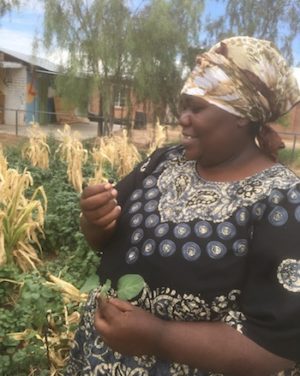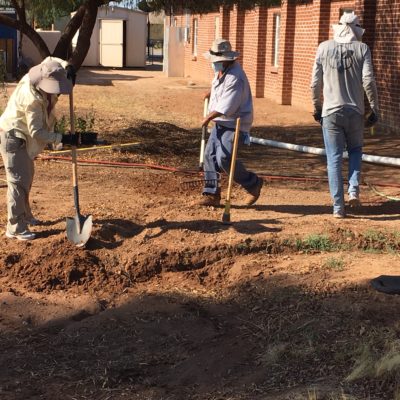
Tatu Louise, lead gardener at Shalom Mennonite Fellowship, with greens, berries and corn from the garden.
Many churches might wish to be “an oasis in the desert,” but few can say this is literally true of their property. Shalom Mennonite Fellowship, Tucson, Ariz., has been transforming a lifeless parking lot into a vibrant desert landscape for several years now. In recent months, a Green Mustard Seed Grant from Mennonite Creation Care Network has helped the oasis flourish.
Shalom used the funds to install drip line, buy plants and parts for a deep mulched basin and educate their group about low-water garden maintenance. The church also provided some education on water conservation and care of rain gardens.
Carol Rose, one of Shalom’s pastors, explains why attention to landscaping is so important to this congregation:
Roads, parking lots and driveways make up a huge portion of Tucson and other U.S. cities. These spaces create heat islands and add to the climate emergency by reflecting heat and preventing absorption of water into the aquifer. This is one of the causes of depletion of the aquifer, which in turn, causes us to use more water brought with electricity from far away. These spaces also do nothing to mitigate climate change by stashing away carbon. They are also ugly.
Shalom Mennonite Fellowship in Tucson had one such parking lot: a baking, pancake-flat space. The good thing about our parking lot was that it was covered with light-colored gravel rather than asphalt. That meant that we didn’t need to work as hard to transform it!
In Tucson, the streets fill with monsoon storm water that rolls off of hard surfaces and even native soil when it falls too fast to be absorbed. There are many indigenous technologies for saving water rather than letting it run off. With the help of Watershed Management Group, Shalom created:
-
- berms across the driving areas of our lot. These are gently raised strips of land that guide the water to the basins.
- basins–holes with gently sloping sides that collect rainwater,
- and swales–shallow channels that allow overflow to move from one basin to another.

Amaranth, a drought-tolerant, highly nutritious green, also grows in the garden. A number of the congregation are from the Congo, and this plant is used in Congolese dishes.
In and around these, we planted native trees, bushes, grasses and flowers. The native grasses are particularly important because their roots create pathways for “planning the water” down into the land to the aquifer.
We lost a couple of parking spaces. We gained incredible beauty and coolness. The growing trees are sequestering carbon. All the rain that falls in that area of our property now soaks in.
When the weather cools down, the group has plans to dig more basins and plant more trees.
